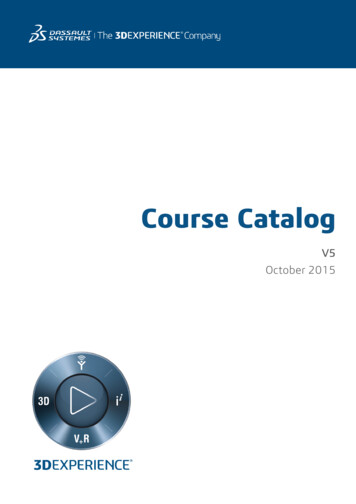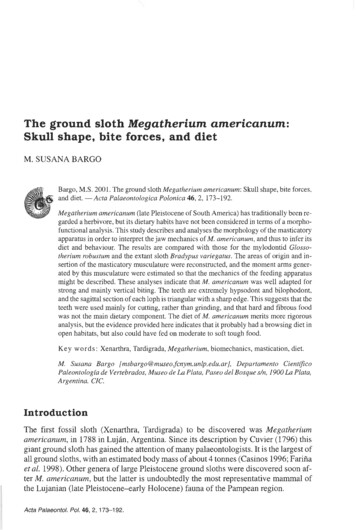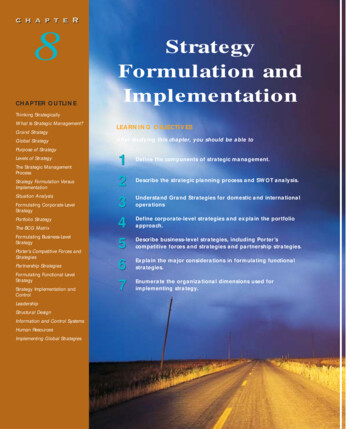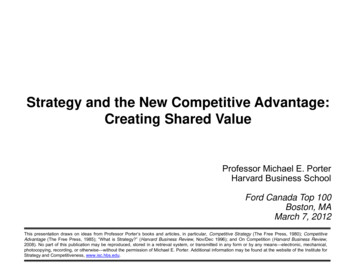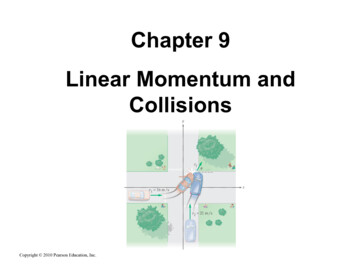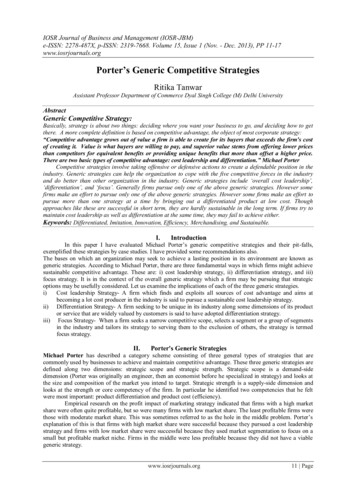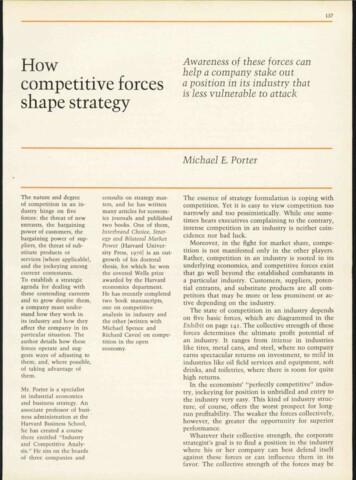
Transcription
137Howcompetitive forcesshape strategyAwareness of these forees canhelp a company stake outa position in its industry thatis less vulnerable to attackMichael E. PorterThe nature and degreeof competition in an industry hinge on fiveforces: the threat of newentrants, the bargainingpower of customers, thebargaining power of suppliers, the threat of substitute products orservices [where applieahle),and the jockeying amongcurrent contestants.To estahlish a strategicagenda for dealing withthese contending currentsand to grow despite them,a company must understand how they work inits industry and how theyaffect the company in itsparticular situation. Theauthor details how theseforees operate and suggests ways of adjusting tothem, and, where possible,of taking advantage ofthem.Mr. Porter is a spcciahstin industrial economicsand business strategy. Anassociate professor of husiness administration at theHarvard Business School,he has created a coursethere entitled "Industryand Competitive Analysis." He sits on the hoardsof three companies andconsults on strategy matters, and he has writtenmany articles for economics journals and publishedtwo books. One of them,Interbrand Choice, Strategy and Bilateral MarketPower (Harvard University Press, 1976) is an outgrowth of his doctoralthesis, for which he wonthe coveted Wells prizeawarded by the Harvardeconomics department.He has recently completedtwo book manuscripts,one on competitiveanalysis in industry andthe other [written withMichael Spence andRichard Caves) on competition in the Dpeneconomy.The essence of strategy formulation is coping withcompetition. Yet it is easy to view competition toonarrowly and too pessimistically. While one sometimes hears executives complaining to the contrary,intense eompetition in an industry is neither coincidence nor bad luck.Moreover, in the fight for market share, competition is not manifested only in the other players.Rather, competition in an industry is rooted in itsunderlying economics, and competitive forces existthat go well beyond the established combatants ina particular industry. Customers, suppliers, potential entrants, and substitute products are all competitors that may be more or less prominent or active depending on tbe industry.The state of competition in an industry dependson five basic forces, wbich are diagrammed in tbeExhibit on page 141. The collective strength of theseforces determines the ultimate profit potential ofan industry. It ranges from intense in industrieslike tires, metal cans, and steel, where no companyearns spectacular returns on investment, to mild inindustries like oil field services and equipment, softdrinks, and toiletries, where there is room for quitehigh returns.In the economists' "perfectly competitive" industry, jockeying for position is unbridled and entry tothe industry very easy. This kind of industry structure, of course, offers the worst prospect for longrun profitability. The weaker the forces collectively,however, the greater the opportunity for superiorperformance.Whatever their collective strength, the eorporatestrategist's goal is to find a position in the industrywhere his or her company ean best defend itselfagainst these forees or can influence them in itsfavor. The collective strength of the forces tnay be
138Harvard Business Reviewpainfully apparent to all the antagonists; but to copewith them, the strategist must delve helow the surface and analyze the sources of eaeh. For example,what makes the industry vulnerable to entry? Whatdetermines the bargaining power of suppliers?Knowledge of these underlying sourees of competitive pressure provides the groundwork for astrategic agenda of action. They highlight the critical strengths and weaknesses of the eompany, animate the positioning of the company in its industry,clarify the areas where strategic changes may yieldthe greatest payoff, and highlight the places whereindustry trends promise to hold the greatest significance as either opportunities or threats. Understanding these sourees also proves to he of help inconsidering areas for diversification.A few characteristics are critical to the strengthof each competitive force. I shall discuss them inthis section.Contending forcesThe strongest competitive force or forces determinethe profitability of an industry and so are of greatestimportance iti strategy formulation. For example,even a company with a strong position in an industry unthreatened by potential entrants will earnlow returns if it faces a superior or a lower-cost substitute produet—as the leading manufaeturers ofvacuum tubes and coffee percolators have learnedto their sorrow, hi such a situation, coping with thesubstitute produet becomes the number one strategic priority.Different forces take on prominence, of course,in shaping competition in each industry. In theoeean-going tanker industry the key force is probably the buyers [the major oil companies), while intires it is powerful OEM buyers coupled with toughcompetitors. In the steel industry the key forces areforeign competitors and substitute materials.Every industry has an underlying structure, ora set of fundamental eeonomic and technical characteristics, that gives rise to these competitive forces.The strategist, wanting to position his company tocope best with its industry environment or to influence that environment in the company's favor,must leam what makes the environment tick.This view of competition pertains equally to industries dealing in services and to those sellingproducts. To avoid monotony in this article, I refer to both produets and services as "products."The same general principles apply to all types ofbusiness.March-April 1979Threat of entryNew entrants to an industry bring new capacity,the desire to gain market share, and often substantial resourees. Companies diversifying through acquisition into the industry from other markets oftenleverage their resources to cause a shake-up, asPhilip Morris did with Miller beer.The seriousness of the threat of entry depends onthe harriers present and on the reaetion from existing eompetitors that the entrant ean expect. If barriers to entry are high and a newcomer can expectsharp retaliation from the entrenched competitors, obviously he will not pose a serious threat ofentering.There are six major sources of barriers to entry:1. Economies of scale—These economies deter entry hy foreing the aspirant either to come in on alarge scale or to accept a cost disadvantage. Scaleeeonomies in produetion, research, marketing, andservice are prohably the key barriers to entry in themainframe computer industry, as Xerox and GEsadly discovered. Economies of scale ean also act ashurdles in distribution, utilization of the sales force,financing, and nearly any other part of a business.2. Product differentiation—Brand identificationereates a barrier by forcing entrants to spend heavilyto overcome customer loyalty. Advertising, eustomer service, being first in the industry, and productdifferences are among the factors fostering brandidentification. It is perhaps the most important entrybarrier in soft drinks, over-the-counter drugs, cosmetics, investment banking, and public accounting.To create high fences around their businesses, brewers couple brand identification with economies ofscale in production, distribution, and marketing.3. Capital requirements—The need to invest largefinancial resources in order to compete creates abarrier to entry, particularly if the capital is requiredfor unrecoverable expenditures in up-front advertising or R&D. Capital is necessary not only for fixedfaeihties but also for customer credit, inventories,and absorbing start-up losses. While major corporations have the finaneial resources to invade almostany industry, the huge capital requirements in certain fields, such as computer manufacturing andmineral extraction, limit the pool of likely entrants.4. Cost disadvantages independent of size—Entrenched companies may have cost advantages notavailable to potential rivals, no matter what their
Competition shapes strategy139The experience curve as an entry barrierIn recent years, the experiencecurve has become widely discussed as a key element ofindustry structure. According tothis concept, unit costs in manymanufacturing industries (somedogmatic adherents say in allmanufacturing industries) aswell as in some service industries decline with "experience,"or a particular company's cumulative volume of production.(The experience curve, whichencompasses many factors, is abroader concept than the betterknown learning curve, whichrefers to the efficiency achievedover a pencxj of time by workersthrough much repetition.)The causes of the decline inunit costs are a combination ofelements, including economiesof scale, the learning curve forlabor, and capital-labor substitution. The cost decline creates abarrier to entry because newcompetitors with no "experience" face higher costs thanestablished ones, particularlythe producer with the largestmarket share, and have difficultycatching up with the entrenchedcompetitors.Adherents of the experiencecurve concept stress the importance of achieving market lead-ership to maximize this barrier toentry, and they recommendaggressive action to achieve it,such as price cutting in anticipation of falling costs in order tobuild volume. For the combatantthai cannot achieve a healthymarket share, the prescription isusually, "Get out,"Is the experience curve anentry barrier on which strategiesshould be built? The answer is:not in every industry. In fact, insome industries, building a strategy on the experience curve canbe potentially disastrous. Thatcosts decline with experience insome industries is not news tocorporate executives. The significance of the experiencecurve for strategy depends onwhat factors are causing thedecline.If costs are falling because agrowing company can reapeconomies of scale throughmore efficient, automated facilities and vertical integration, thenthe cumulative volume of production is unimportant to its relative cost position. Here thelowest-cost producer is the onewith the largest, most efficientfacilities,A new entrant may well bemore efficient than the moreexperienced competitors; if ithas built the newest plant, it willface no disadvantage in havingto catch up. The strategic prescription, "You must have thelargest, most efficient plant," is alot different from, "You mustproduce the greatest cumulativeoutput of the item to get yourcosts down,"Whether a drop in costs withcumulative (not absolute) volume erects an entry barrier alsodepends on the sources of thedecline. If costs go downbecause ot technical advancesknown generally In the industryor because of the developmentof improved equipment that canbe copied or purchased fromequipment suppliers, the experience curve is no entry barrier atall-infact, new or less experienced competitors may actuallyenjoy a cost advantage over theleaders. Free of the legacy ofheavy past investments, thenewcomer or less experiencedcompetitor can purchase orcopy the newest and lowest-costequipment and technology.If, however, experience canbe kept proprietary, the leaderswill maintain a cost advantage.But new entrants may requireless experience to reduce theircosts than the leaders needed.All fhis suggests that the experience curve can be a shakyentry barrier on which to build astrategy.While space does not permit acomplete treatment here, I wantto mention a few other crucialelements in determining theappropriateness of a strategybuilt on the entry barrier provided by the experience curve;D The height of the barrierdepends on how important costsare to competition comparedwith other areas like marketing,selling, and innovation,D The barrier can be nullifiedby product or process innovations leading to a substantiallynew technology and therebycreating an entirely new experience curve,' New entrants canleapfrog the industry leadersand alight on the new experience curve, to which thoseleaders may be poorly positioned to jump,D If more than one strongcompany is building its strategyon the experience curve, theconsequences can be nearlyfatal. By the time only one rival isleft pursuing such a strategy,industry growth may havestopped and the prospects ofreaping the spoils of victory longsince evaporated."For an example drawn Irom Ihehistoryol the automobile industry, see William J.Abematfiy and Kenneth Wayne, "The Limits of the Learning Curve," HBR SeptemberOctober 1974, p.109.size and attainable economics of scale. These advantages ean stem from the effeets of the learningeurve (and of its first eousin the experience curve),proprietary teehnology, access to the best raw materials sources, assets purchased at preinflationprices, government subsidies, or favorable locations.Sometimes cost advantages are legally enforceable,as they are through patents. (For an analysis of thetnuch-discussed experience curve as a barrier toentry, see the ruled insert above.)5. Access to distribution channeh—Thc new boyon the block must, of course, secure distribution ofhis product or service. A new food product, for ex-ample, must displace others from the supermarketshelf via price breaks, promotions, intense sellingefforts, or some other means. The more limited thewholesale or retail channels are and the more thatexisting competitors have these tied up, obviouslythe tougher that entry into the industry will be.Sometimes this barrier is so high that, to surmountit, a new contestant must create its own distributionchannels, as Timex did in the watch industry int h e 19SOS.6. Government policy—The government can limitor even foreclose entry to industries with such controls as license requirements and limits on access to
140Harvard Business Reviewraw materials. Regulated industries like trucking,liquor retailing, and freight forwarding are noticeable examples; more subtle government restrictionsoperate in fields like ski-area development and eoalmining. The government also can play a major indirect role by affecting entry barriers through controls sueh as air and water pollution standards andsafety regulations.Powerful suppliers &l buyersThe potential rival's expectations about the reactionof existing competitors also will infiuence its decision on whether to enter. The company is likely tohave second thoughts if incumbents have previously lashed out at new entrants or if: The incumbents possess substantial resourcesto fight baek, including excess cash and unused borrowing power, productive capacity, or clout with distribution channels and customers. The incumbents seem likely to cut prices because of a desire to keep market shares or becauseof industrywide excess capacity.n Industry growth is slow, affecting its ability toabsorb the new arrival and probably causing thefinancial performance of all the parties involved todecline.Changing conditionsFrom a strategic standpoint there are two importantadditional points to note about the threat of entry.First, it changes, of course, as these conditionschange. The expiration of Polaroid's basic patentson instant photography, for instance, greatly reduced its absolute cost entry barrier built by proprietary technology. It is not surprising that Kodakplunged into the market. Product differentiation inprinting has all but disappeared. Conversely, in theauto industry economies of scale increased enormously with post-World War II automation and vertical integration—virtually stopping successful newentry.Second, strategic deeisions involving a large segment of an industry can have a major impact on theconditions determining the threat of entry. For example, the actions of many U.S. wine producers inthe 1960s to step up produet introductions, raise advertising levels, and expand distribution nationallysurely strengthened the entry roadblocks by raisingeeonomies of scale and making access to distributionchannels more difficult. Similarly, decisions bymembers of the recreational vehicle industry tovertically integrate in order to lower costs havegreatly increased the economies of scale and raisedthe capital cost barriers.March-April 1979Suppliers can exert bargaining power on participantsin an industry by raising prices or reducing thequality of purchased goods and services. Powerfulsuppliers can thereby squeeze profitability out of anindustry unable to recover cost increases in its ownprices. By raising their prices, soft drink coneentrateproducers have contributed to the erosion of profitability of bottling companies because the bottlers,facing intense competition from powdered mixes,fruit drinks, and other beverages, have limited freedom to raise their prices accordingly. Customerslikewise can force down prices, demand higherquality or more service, and play competitors offagainst each other—all at the expense of industryprofits.The power of each important supplier or buyergroup depends on a number of characteristics of itsmarket situation and on the relative importance ofits sales or purchases to the industry compared withits overall business.A supplier group is powerful if:D It is dominated by a few companies and is moreconcentrated than the industry it sells to.D Its product is unique or at least differentiated,or if it has built up switching costs. Switching costsare fixed costs buyers face in changing suppliers.These arise beeause, among other things, a buyer'sproduet specifications tie it to particular suppliers,it has invested heavily in specialized ancillary equipment or in learning how to operate a supplier'sequipment [as in computer software), or its production lines are connected to the supplier's manufacturing facilities (as in some manufacture of beveragecontainers).D It is not obliged to contend with other produetsfor sale to the industry. For instance, the competition between the steel companies and the aluminum companies to sell to the can industry checksthe power of eaeh supplier.n It poses a credihle threat of integrating forwardinto the industry's business. This provides a checkagainst the industry's ability to improve the termson which it purchases.D The industry is not an important customer ofthe supplier group. If the industry is an importantcustomer, suppliers' fortunes will be closely tied tothe industry, and they will want to protect the industry through reasonable pricing and assistance inactivities like R&D and lobbying.A buyer group is powerful if: It is concentrated or purchases in large volumes. Large-volume buyers are particularly potent
Competition shapes strategyforces if heavy fixed costs characterize the industry—as they do in metal containers, corn refining, andbulk chemicals, for example—which raise the stakesto keep capacity filled.D The products it purchases from the industryare standard or undifferentiated. The huyers, surethat they can always find alternative suppliers, mayplay one company against another, as they do inaluminum extrusion.D The products it purehases from the industryform a component of its product and represent asignificant fraction of its cost. The huyers are likelyto shop for a favorable priee and purchase selectively. Where the product sold by the industry inquestion is a small fraction of buyers' costs, buyersare usually much less price sensitive. It earns low profits, wbich create great incentive to lower its purchasing costs. Highly profitablebuyers, however, are generally less price sensitive(that is, of course, if the item does not represent alarge fraction of their costs).D The industry's product is unimportant to thequality of the buyers' products or services. Wherethe quality of the buyers' products is very muchaffected by the industry's product, buyers are generally less price sensitive. Industries in which thissituation obtains include oil field equipment, wherea malfunction cati lead to large losses, and enclosures for electronic medical and test instruments,where the quality of the enclosure ean influence theuser's impression about the quality of the equipment inside.n The industry's product does not save the buyermoney. Where the industry's product or service canpay for itself many times over, the buyer is rarelyprice sensitive; rather, he is interested ita quality.This is true in services like investment banking andpublic accounting, where errors in judgment can becostly and embarrassing, and in businesses like thelogging of oil wells, where an accurate survey cansave thousands of dollars in drilling costs. The buyers pose a credible threat of integrating backward to make the industry's product. TheBig Three auto producers and major buyers of carshave often used the threat of self-manufacture as abargaining lever. But sometimes an industry engenders a threat to buyers that its members may integrate forward.Most of these sources of buyer power can be attributed to eonsumers as a group as well as to industrial and commercial buyers; only a modification of the frame of reference is tieccssary. Consumers tend to be more price sensitive if they are purchasing products that are undifferentiated, expen-141ExhibilForces governing competition in an industrysive relative to their incomes, and of a sort wherequality is not particularly important.The buying power of retailers is determined bythe same rules, with one important addition. Retailers can gain significant bargaining power overmanufacturers when they can influence consumers'purchasing decisions, as they do in audio components, jewelry, appliances, sporting goods, and othergoods.Strategic actionA company's choice of suppliers to buy from orbuyer groups to sell to should be viewed as a crucialstrategic decision. A company can improve its strategie posture by finding suppliers or buyers whopossess the least power to influence it adversely.Most common is the situation of a company beingable to choose whom it will sell to—in otber words,buyer selection. Rarely do all the buyer groups acompany sells to enjoy equal power. Even if a company sells to a single industry, segments usually existwithin that industry that exercise less power [andthat are therefore less price sensitive) than others.For example, the replacement market for most produets is less price sensitive than the overall market.
March-April 1979142Harvard Business ReviewAs a rule, a company can sell to powerful buyersand still come away with above-average profitability only if it is a low-cost producer in its industry orif its product enjoys some unusual, if not unique,features. In supplying large customers with electricmotors, Emerson Electric earns high returns becauseits low cost position permits the company to meetor undercut competitors' prices.If the company lacks a low cost position or aunique product, selling to everyone is self-defeatingbecause the more sales it achieves, the more vulnerable it becomes. The company may have to muster the courage to turn away business and sell onlyto less potent customers.Buyer selection has been a key to the success ofNational Can and Crown Cork & Seal. They focuson the segments of the can industry where they cancreate product differentiation, minimize the threatof backward integration, and otherwise mitigate theawesome power of their customers. Of course, someindustries do not enjoy the luxury of selecting"good" buyers.As the factors creating supplier and buyer powerchange with time or as a result of a company'sstrategic decisions, naturally tbe power of thesegroups rises or deelines. In the ready-to-wear clothing industry, as the buyers (department stores andclothing stores) have become more concentrated andcontrol has passed to large chains, the industry hascome under increasing pressure and suffered fallingmargins. The industry has been unable to differentiate its product or engender switching costs thatlock in its buyers enough to neutralize these trends.pered by the plethora of insulation suhstitutes, ineluding cellulose, rock wool, and styrofoam. Thesesubstitutes are bound to become an even strongerforce once the current round of plant additions byfiberglass insulation producers has boosted capacityenough to meet demand (and then some).Substitute products that deserve the most attention strategically are those that (a) are subject totrends improving their price-performance trade-ofTwith the industry's produet, or (b) are produced byindustries earning high profits. Substitutes oftencome rapidly into play if some development increases competition in their industries and causesprice reduction or performance improvement.Substitute productsBy placing a ceiling on prices it can charge, substitute products or services limit the potential of anindustry. Unless it can upgrade the quality of theproduct or differentiate it somehow (as via marketing), the industry will suffer in earnings and possibly in growth.Manifestly, the more attractive the price performance trade-off offered by substitute products, thefirmer the lid placed on the industry's profit potential. Sugar producers confronted with the large scalecommercialization of high-fructose corn syrup, asugar substitute, are learning this lesson today.Substitutes not only limit profits in normal timcs;they also reduce the bonanza an industry can reapin boom times. In 1978 the producers of fiberglassinsulation enjoyed unprecedented demand as a result of high energy costs and severe winter weather.But the industry's ability to raise prices was tem-fockeying for positionRivalry among existing competitors takes the familiar form of jockeying for position—using tactics likeprice competition, product introduction, and advertising slugfests. Intense rivalry is related to the presence of a number of factors:n Competitors are numerous or are roughly equalin size and power. In many U.S. industries in recentyears foreign contenders, of course, have becomepart of the competitive picture. Industry growth is slow, precipitating fightsfor market share that involve expansion-mindedmembers.D The product or service lacks differentiationor switching costs, wbich lock in buyers and protectone combatant from raids on its customers by another.D Fixed costs are high or the product is perishable, creating strong temptation to cut prices.Many basic materials businesses, like paper andaluminum, suffer from this problem when demandslackens.n Capacity is normally augmented in large inerements. Such additions, as in the chlorine and vinylchloride businesses, disrupt the industry's supplydemand balance and often lead to periods of overcapacity and price cutting.D Exit barriers are high. Exit barriers, like veryspecialized assets or management's loyalty to a particular business, keep companies competing eventhough they may be earning low or even negativereturns on investment. Excess capacity remainsfunctioning, and the profitability of the healthycompetitors suffers as the sick ones hang on. Ifthe entire industry suffers from overcapacity, it mayi. Fur a mure complttL- dis;:ussion of exit barriers anJ ihcit implitatinns finstrategy, sec my article, "Please Note Lniiation of Nearest Exit," CohjornlaMani!f!,ctni!ntReview,Winttr1976, p- '-
Competition shapes strategyseek government help—particularly if foreign competition is present. The rivals are diverse in strategies, origins, and"personalities." They have different ideas ahouthovk' to compete and continually run head-on intoeach other in the process.As an industry matures, its growth rate changes, resulting in deelining profits and (often) a shakeout.In the hooming recreational vehicle industry of theearly 1970s, nearly every producer did well; but slowgrowth since then has eliminated the high returns,except for the strongest members, not to mentionmany of the weaker companies. The same profitstory has heen played out in industry after industry—snowmobiles, aerosol packaging, and sports equipment are just a few examples.An acquisition can introduce a very different personality to an industry, as has been the case withBlack fit Decker's takeover of McCuUough, theproducer of chain saws. Technological innovationcan boost the level of fixed costs in the productionprocess, as it did in the shift from batch to continuous-line photo finishing in the 1960s.While a company must live with many of thesefactors—hecause they are built into industry economies—it may have some latitude for improvingmatters through strategic shifts. For example, it maytry to raise buyers' switching costs or increase product differentiation. A focus on selling efforts inthe fastest-growing segments of the industry or onmarket areas with the lowest fixed costs ean reducethe impact of industry rivalry. If it is feasible, acompany can try to avoid confrontation with competitors having high exit barriers and ean thus sidestep involvement in bitter price cutting.Formulation of strategyOnee the corporate strategist has assessed the forcesaffecting competition in his industry and their underlying causes, he ean identify his eompany'sstrengths and weaknesses. The crucial strengths andweaknesses from a strategie standpoint are the company's posture vis-a-vis the underlying causes ofeach force. Where does it stand against substitutes?Against the sourees of entry barriers?Then the strategist can devise a plan of action thatmay include (1) positioning the company so that itscapabilities provide the best defense against the143competitive force; and/or (2) influencing the balance of the forces through strategic moves, therebyimproving the company's position; and/or (3) anticipating shifts in the factors underlying the forcesand responding to them, with the hope of exploiting change hy choosing a strategy appropriatefor the new competitive balanee before opponentsrecognize it. I shall consider each strategic approachin turn.Positioning the companyThe first approach takes the structure of the industry as given and matches the company's strengthsand weaknesses to it. Strategy can be viewed asbuilding defenses against the competitive forces oras find
competitive forces shape strategy Awareness of these forees can help a company stake out a position in its industry that is less vulnerable to attack Michael E. Porter The nature and degree of competition in an in-dustry hinge on five forces: the threat of new entrants, the bargaining power
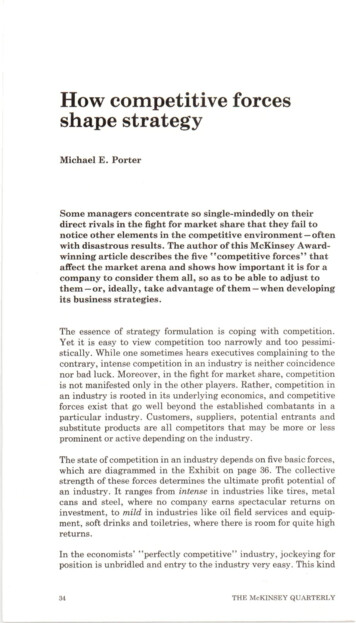
![05[2] Strategy competitors, competitive rivalry .](/img/2/052-strategy-competitors-competitive-rivalry-competitive-behavior-and-competitive-dynamics.jpg)
